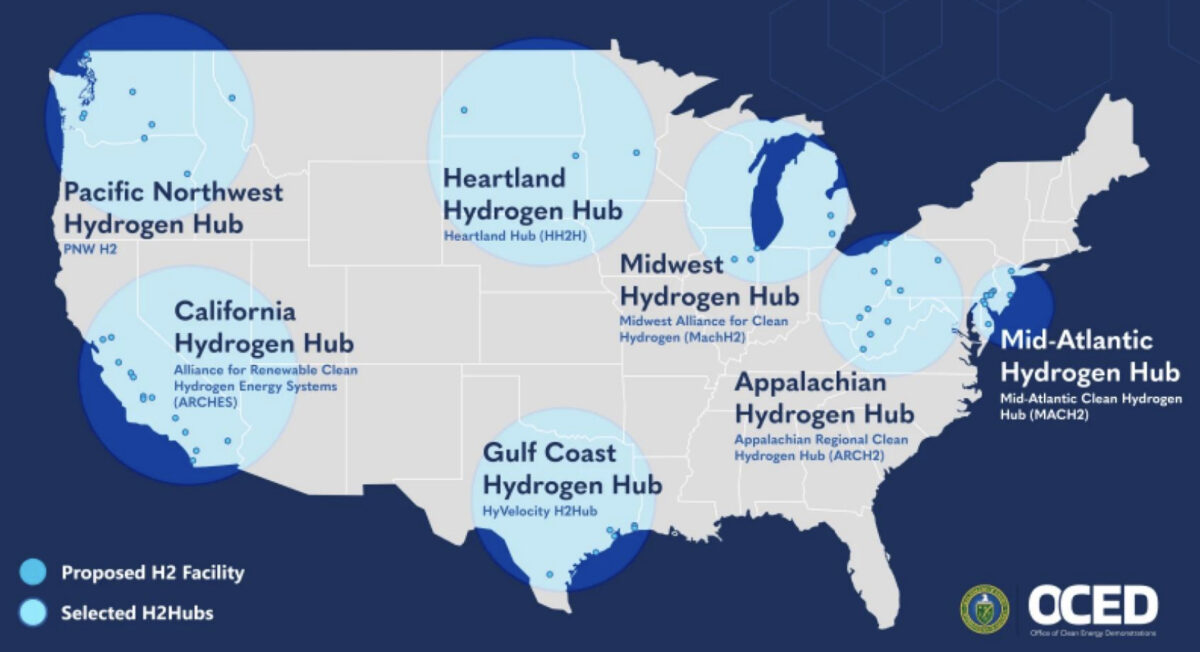Numerous concerns about federally funded hydrogen hubs add up to “a lot of bad news,” said Abbe Ramanan, a project director with Clean Energy Group, on a webinar with energy research group IEEFA and the Pipeline Safety Trust.
The hydrogen hubs are intended to pair large-scale clean hydrogen production with industrial and other end-uses for hydrogen. Yet most of the hydrogen hubs to be funded by the U.S. Department of Energy (DOE) will produce “blue” hydrogen, Ramanan said.
Blue hydrogen involves fossil fuel combustion and is “not clean or low-carbon,” said Anika Juhn, an analyst with research group IEEFA. A report from the group says blue hydrogen “will be very dirty.”
“Green” hydrogen, made from electrolysis of water powered by renewables, has been seen as an option for multi-day or seasonal storage of renewable energy—for example, where salt caverns can be created to store hydrogen on-site. Research group Energy Innovation last year projected that green hydrogen production could be profitable in “wide swaths” of the U.S., mostly in the central U.S.
The seven hydrogen hubs selected for federal support are now engaged in an award negotiation process. Yet even though DOE committed, Ramanan said, to “heavily weigh community benefit plans and community engagement” in the negotiation process, Clean Energy Group has heard from “a lot” of community groups that have been unable to learn how to engage with the hubs, what hydrogen projects will be involved in each hub, or how those projects will impact and possibly benefit their communities.
No matter how hydrogen is produced, transporting it in pipelines presents risk, said Amanda McKay, policy manager with the Pipeline Safety Trust. Small hydrogen molecules interact with steel and certain polyethylene pipes, she said, leading to embrittlement and cracking. She said that a hydrogen pipeline is “more likely to explode” than methane pipelines. McKay began her presentation with a tragic story of a gasoline pipeline leak and fireball in Washington State that claimed the lives of three boys.
Regarding proposals to mix a small portion of hydrogen with methane, McKay said that because hydrogen has less energy content than methane per unit of volume, mixing 10% hydrogen with 90% methane reduces combustion CO2 emissions by only 3%. Moreover, hydrogen is an indirect greenhouse gas, she said.
The seven hydrogen hubs selected by DOE for $7 billion in awards would also receive federal tax incentives estimated by Clean Energy Group at $70 billion in over ten years, consisting of hydrogen production incentives for all projects and carbon capture incentives for blue hydrogen production.
Carbon capture incentives are key to the economics of blue hydrogen projects, said IEEFA’s Anika Juhn, yet federal incentives will not lead to a high rate of carbon capture. She described a project in Louisiana to produce hydrogen from coal gasification that is set to receive $425 million per year in carbon capture credits, while capturing only 64% of the associated lifetime CO2-equivalent emissions.
Juhn critiqued the GREET model used by DOE to project a hydrogen project’s carbon emissions, challenging four assumptions used in the model.
David Schlissel, an analyst at IEEFA, said “there’s not enough demand” for the hydrogen to be produced by “these projects that we’re going to pay to build.” He forecasted potential markets for hydrogen for ammonia production and iron production, but not for transportation or home heating.
Schlissel and Suzanne Mattei, also an IEEFA analyst, wrote in an op-ed last fall that “full funding of these projects is not yet guaranteed. DOE will now enter into negotiations with the selected project sponsors about funding, which will be allocated in four decision-making phases.”
This content is protected by copyright and may not be reused. If you want to cooperate with us and would like to reuse some of our content, please contact: editors@pv-magazine.com.








By submitting this form you agree to pv magazine using your data for the purposes of publishing your comment.
Your personal data will only be disclosed or otherwise transmitted to third parties for the purposes of spam filtering or if this is necessary for technical maintenance of the website. Any other transfer to third parties will not take place unless this is justified on the basis of applicable data protection regulations or if pv magazine is legally obliged to do so.
You may revoke this consent at any time with effect for the future, in which case your personal data will be deleted immediately. Otherwise, your data will be deleted if pv magazine has processed your request or the purpose of data storage is fulfilled.
Further information on data privacy can be found in our Data Protection Policy.